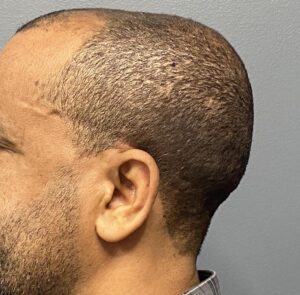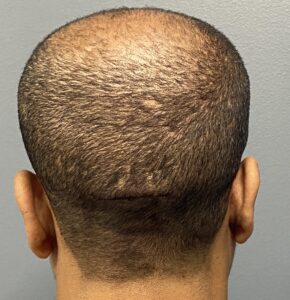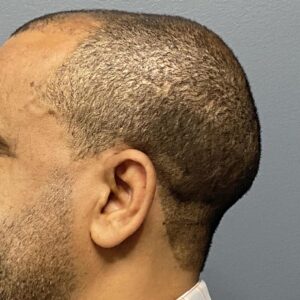Background: The back of the head is commonly referred as the occiput even though this is not anatomically correct. The back of the head is actually comprised of the paired parietal bones superiorly and the singular central occipital bone inferiorly What separates the three bones is the inverted Y-shaped suture line, particularly the lambdoidal suture line which separates the parietal and occipital bone.
When the occipital bone overgrows it becomes protrusive, sticking out beyond the convex contour of the lambdoidal suture and parietal bone above it. This is frequently referred to as an occipital bun, referring to a bun hairstyle. (at least I believe this is where its name likely emanates) Because it is an overgrowth it is most commonly due to excessive bone thickening. The occipital is already the thickest bone of the visible skull but it is always prudent to check an x-ray to ensure that is the case when surgical reduction is being considered. It is possible that it is a herniation of the brain into the occipital bone, which would mean the bone is thinner and not thicker, but I have yet to see that cause of a bun deformity.
All occipital buns can be reduced, the only question is by how much. This is determined by the thickness of the outer table of the skull protrusion. Skull bone for aesthetic purposes can be safely taken down until diploic space is encountered which is the stopping point. This leaves a safety margin of the inner cortical layer of bone over the brain. Based on this stopping question becomes then will this be a partial or complete reduction of the skull protrusion.

Under general anesthesia and in the prone position as much reduction of the bun was done as was felt safe through a limited low horizontal scalp incision. You can never fully tell in surgery how much of a difference one is making. But there is always lots of bone dust/particles that is created. The scalp incision was closed over a drain and a head dressing was applied.


Case Highlights:
1) Occipital skull protrusion/bun is where the visible occipital bone up to the lambdoid sutures projects further out than the rest of the skull around it.
2) How much the occipital skull bun can be reduced depends on the thickness of the outer cortical table of bone.
3) Through a low horizontal scalp incision the outer table of the bun protrusion is reduced as much as possible (until the diploic space is encountered …which may or may not completely remove the skull protrusion.
Dr. Barry Eppley
World-Renowned Plastic Surgeon



